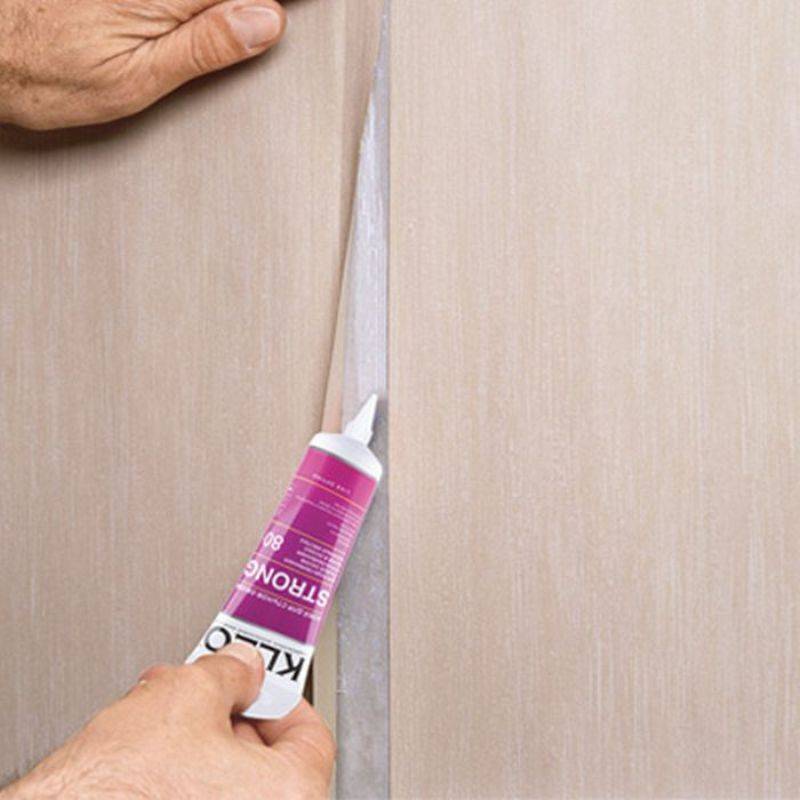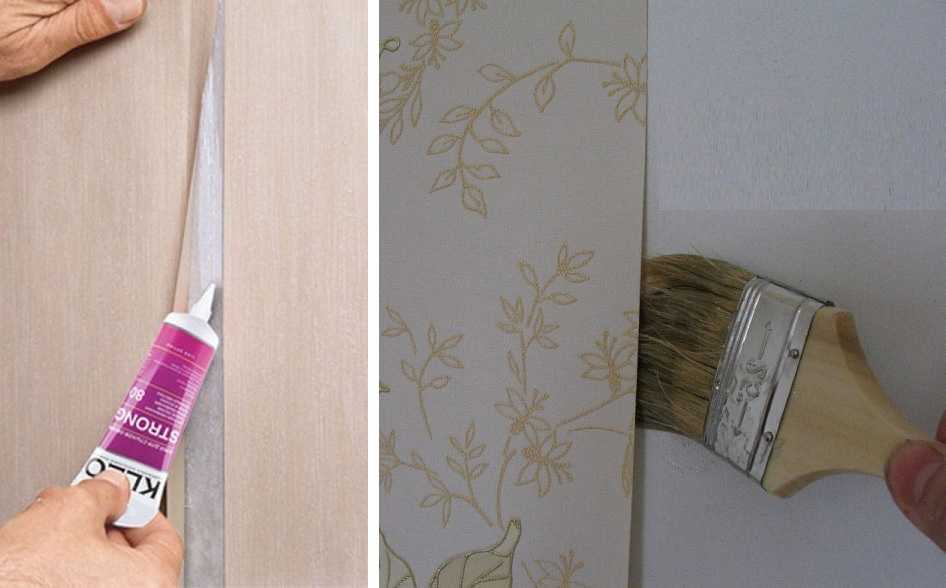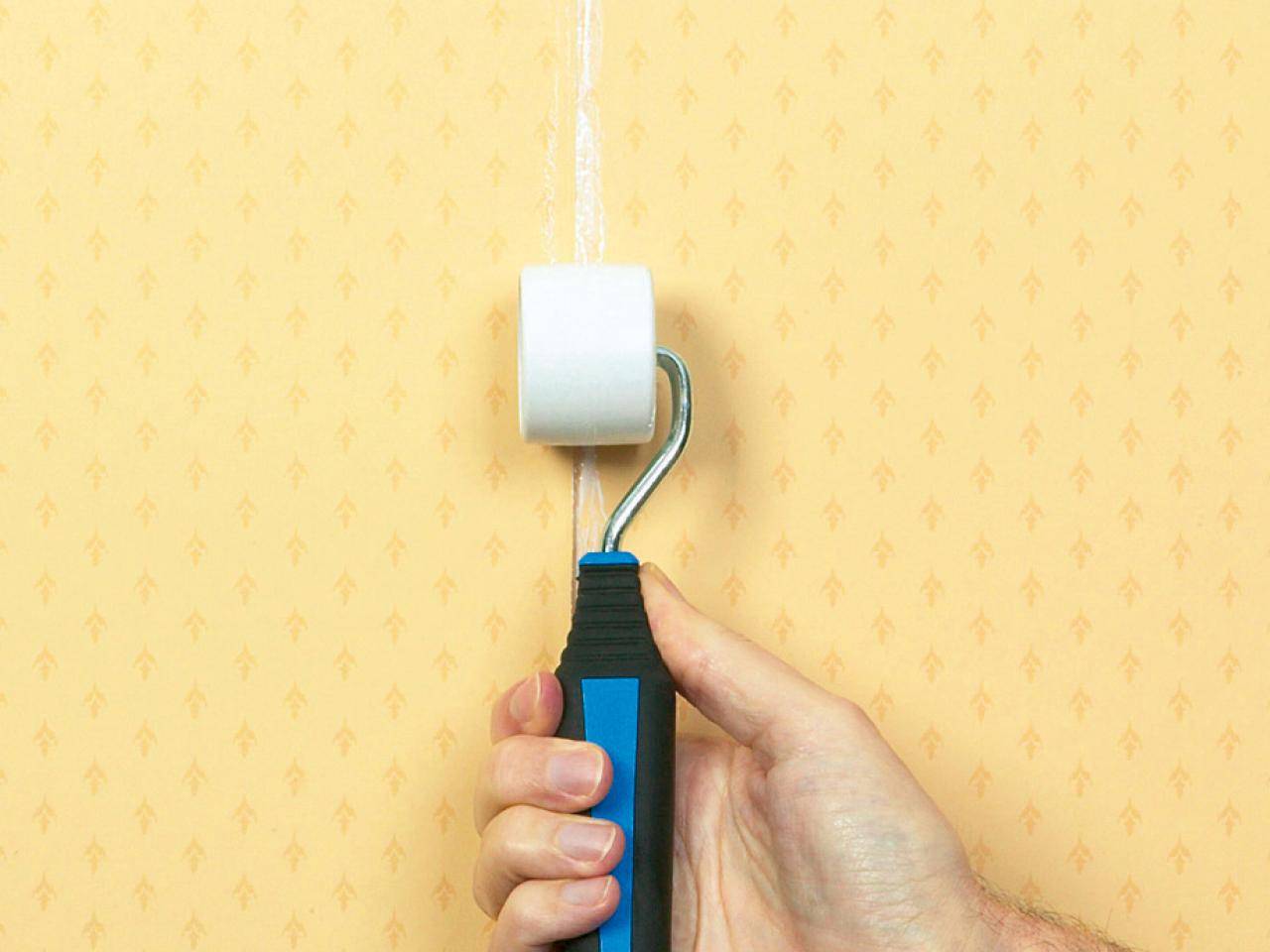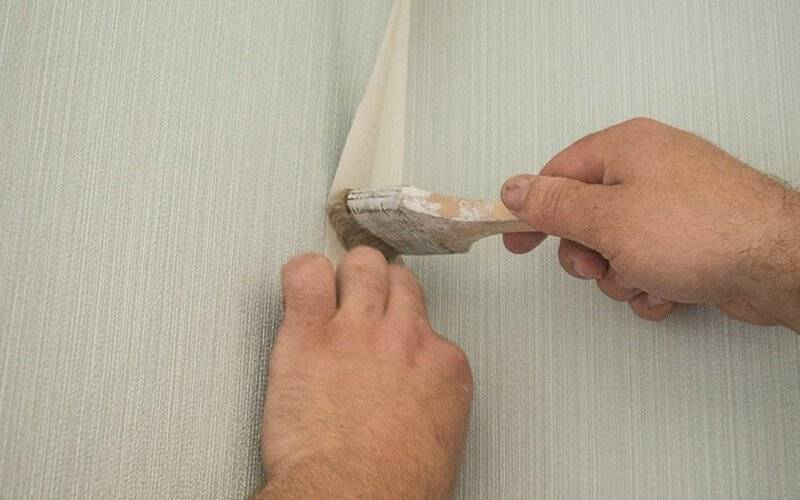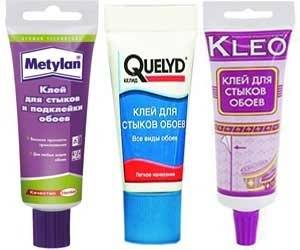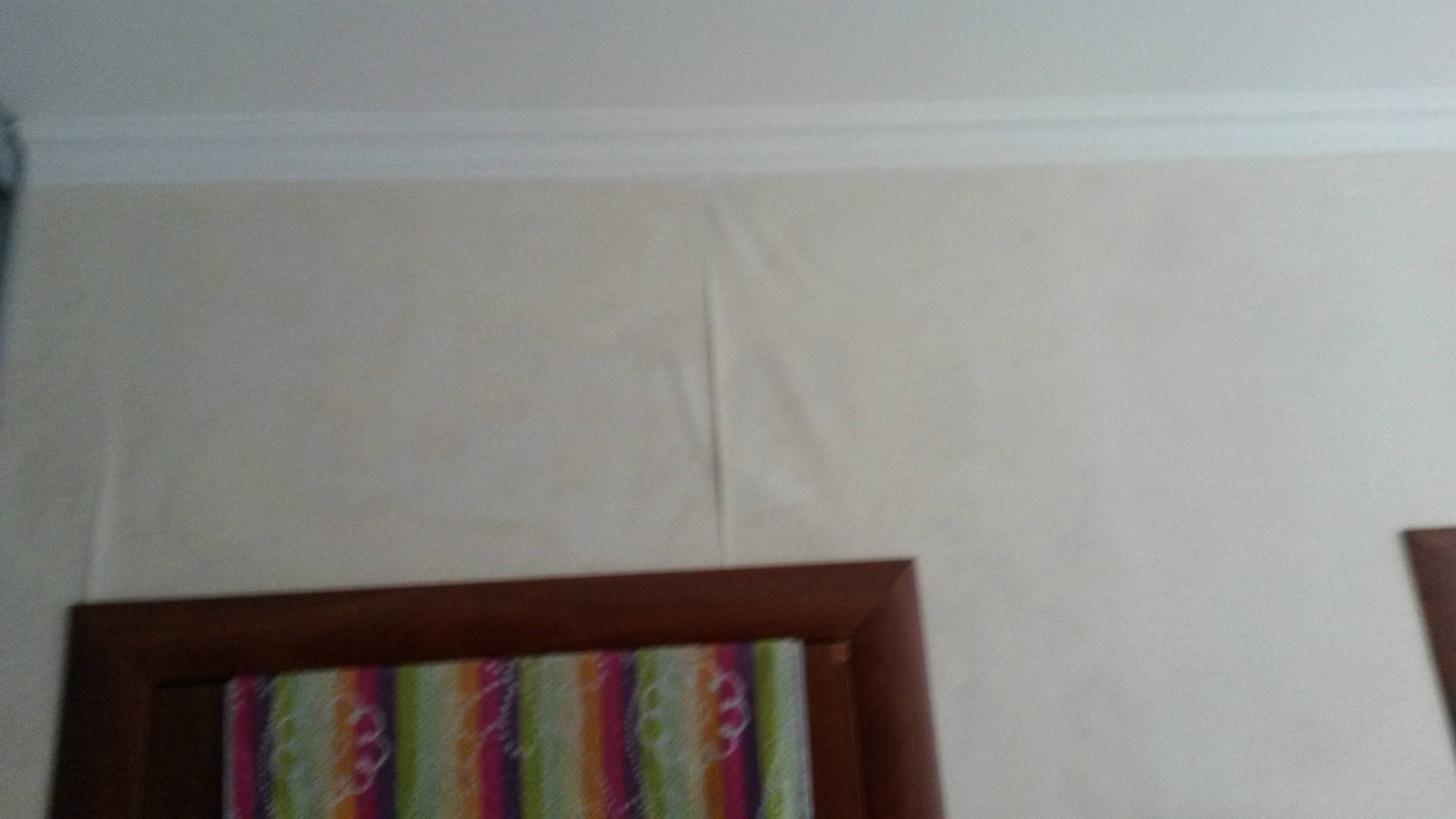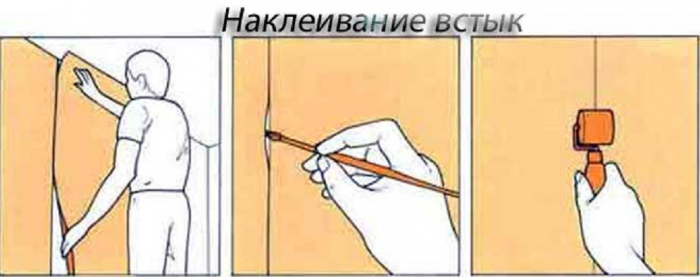How to glue the wallpaper at the joints if they have diverged
It is not advisable to throw away the powder-glue remaining after the repair, it will serve as insurance in case of defects in the finish coating. It must be diluted with water in the proportions indicated by the manufacturer.
The joints of the canvases need to be slightly widened so that it is more convenient to distribute the adhesive composition. A narrow brush is useful to ensure uniformity. The glue-treated canvases should be pressed firmly, smoothing the joint with a clean rag. If there are air bubbles under the wallpaper, you can use a plastic spatula when smoothing.
PVA glue is suitable for working with paper webs, although it should be remembered that it can cause other problems. The "behavior" of polyvinyl acetate products differs depending on the manufacturer, sometimes brown or yellowish spots appear on the wallpaper after them. Masters advise to dilute PVA with water in a ratio of 1: 1 or combine it with wallpaper glue in a ratio of 1:10.
This option is not suitable for vinyl and non-woven materials; it is advisable to choose glue for the joints for them. The main advantage here is the versatility of the composition - it is suitable for all types of canvases and creates a reliable connection. The special joint glue stands out for its ease of application: it is packed in tubes with a narrow tip. The product is already ready for use, it does not need to be diluted. When gluing wallpaper, manufacturers recommend maintaining the room temperature at +10 - + 25 °.
In order to prevent delamination of joints in the future even at the stage of repair, you can glue paper tape between the canvases. This is a special narrow product that enhances the fixation of the wallpaper. The solution is not suitable for thin non-woven and paper coverings, but works well with heavy vinyl sheets.
The search for working glue is only the first stage of repairing joints, the gluing process deserves more strength and responsibility. Operation Guide:
The canvases at the joint should be carefully unscrewed.
Use a vacuum cleaner with a narrow nozzle to remove dust and debris. If an old layer of whitewash or loose filler is visible, they must be removed.
In case of destruction of the putty layer, the seam zone must be worked out again with putty and covered with a primer, and then wait until it dries. Glue is evenly applied to the joint, and the edges of the wallpaper are pressed and rolled with a rubber roller.
The entire plane should be smoothed out with a plastic spatula, at the same time wiping off the glue that has come out with a clean rag.
Often, during gluing, voids are formed - air bubbles, they should be carefully pierced with a needle. Joint glue or wallpaper solution is injected into such areas with a syringe, and the excess should be removed with a rag. If simple PVA is used for gluing, the masters advise to immediately process the joints with an iron or hairdryer: high temperature contributes to the formation of a strong connection.
Do not feel sorry for the mixture: it is necessary to generously coat the wall and wallpaper. In some cases, in order for them to be well saturated, you will have to wait 10-15 minutes according to the recommendation of the material manufacturer.
Is it possible to mask the joint
The question is relevant in situations where a thin strip of wall appears in the restored seam, which is especially noticeable on dark wallpaper. To prevent the light stripe from standing out, it can be painted over to match the color of the finish. In such a situation, water-based paint is suitable, if the pigment is too saturated, then a little of the product is diluted with water.
What can you use?
When the joints have already parted at the seams, it is important to glue them as quickly as possible. This can be done using the following means:
- glue;
- brushes;
- spatula;
- rubberized roller;
- syringe;
- tube with a special dispenser.
Nevertheless, some people use similar compounds for gluing, subsequently suffering with the peeling off of the canvases, since PVA fixes the tapestries perfectly. Wallpaper can disperse at the seams even if bubbles form on the surface, which means that the canvas is uneven. You can get rid of unwanted relief using a conventional syringe. The algorithm of actions is as follows:
- pierce a bubble with a needle from a syringe;
- remove the formed air between the wall and the trellis;
- fill the syringe with glue;
- put a syringe with an adhesive inside the canvas;
- wait until the wallpaper is completely impregnated;
- Press the area to be restored firmly and smooth with a roller.
I must say that today on sale you can see special reinforced adhesives for joints. They are distinguished by high viscosity due to the presence of a polyvinyl acetate emulsion in the composition. In addition, the drying speed of any of the professional types of products is several times faster than the drying speed of classic wallpaper glue. The resulting coating acquires not only high strength, but also water resistance.
In the case when there is no glue, some masters advise using a solution of flour or starch and warm water. Experts discourage the use of this method, but for some it becomes a budget bailout. Nevertheless, there are traditional methods, and therefore the method of making homemade paste is worth mentioning. So, for the adhesive you will need:
- a glass of flour;
- 2 tablespoons of starch;
- 2 liters of water.
The amount of ingredients in this case is presented in a large portion, however, it can always be changed. So, they put water on fire and wait for it to boil. Flour and starch are mixed with each other and poured with a small amount of cold water until the lumps are completely dissolved. The resulting mass is poured into boiling water with constant stirring in a thin stream. Within 1 minute, the mass is continued to stir, and then cooled. To get rid of lumps, the liquid must be filtered through a colander.
How to glue unstuck wallpaper.
If the wallpaper peeled off and partially torn off the whitewash, paint or putty from the wall, then they must be cleaned with warm water. Do this carefully so as not to damage the canvas. If there is nothing on the canvas, immediately start gluing them.
To do this, use a brush to apply glue to the wallpaper, which has come off and on the wall. The canvas should soften for 1-2 minutes, then start smoothing with a wallpaper trowel. When applying glue, do not feel sorry for it. Better for the glue to come out of the seam than not enough.
The glue for gluing is the same as for gluing wallpaper. Therefore, after gluing the wallpaper, you need to leave the glue. In the cooked state, it can stand for a relatively long time. As practice shows, most often the wallpaper peels off the next day or every other day. During this time, nothing will happen to the prepared glue.
If the wallpaper has come off in you after a few months or years and you do not have the wallpaper glue with which you glued the wallpaper, do not rush to buy a new pack. You do not use it completely, but it is better to glue it with PVA glue. All types of wallpaper can be glued with this glue.
In order for you to clearly see that there is nothing heavy in gluing, I will provide you with this video.
Often, after a while, ours ceases to look as attractive as at the very beginning. Sprinkles, wallpaper peels off in places. But this is not a reason to start a new repair, you can just fix the old one and extend its life for several more years.
Why does wallpaper lag behind the wall?
Most often, the reason is inaccurate adherence to the gluing instructions. This is especially true for heavy types of wallpaper that require special glue and additional materials, for example, paper strips at the joints.
Also, the reason may lie in insufficient quality surface preparation or uneven application of glue. The removal of wallpaper is sometimes explained by the dampness of the room. Bathrooms and in the kitchen, the wallpaper peels off often and thickly. And what to do if the wallpaper is peeled off and we are not planning repairs yet?

Renovating wallpaper joints on time can save time and money
In doing so, it is important to choose the right glue and tools. So, how to glue the unsticked wallpaper: you need a special glue, it is preferable to choose a well-known manufacturer
You will also need a small roller specifically for rolling the joints.
We also prepare a sponge to remove excess glue, a vacuum cleaner and a household hair dryer. How to fix the wallpaper at the junction if they come off: first, carefully spread the loose sheets, vacuum the wall and the wallpaper itself, in order to remove dust and putty crumbs. We apply glue from a tube or with a brush (depending on the area of the unsticked wallpaper).
Next, roll the wallpaper sheets in the direction from the glued part to the joint. Remove the protruding glue with a damp sponge. If you glue PVA, dry the seams additionally with a hairdryer and then roll again.

Let the wallpaper dry, while avoiding drafts. The mini-renovation is over!
Some time after the renovation, many apartment owners are faced with minor troubles: the wallpaper is moving away or bubbling.
Wallpaper peeling off: what should be done? As a rule, such defects can be corrected on their own without the help of professionals.
Hardware stores offer ready-made mixtures with which you can glue wallpaper. In addition, you can do with improvised means, preparing the composition with your own hands.
 Most often, the wallpaper peels off if the base was prepared incorrectly
Most often, the wallpaper peels off if the base was prepared incorrectly
To avoid trouble in the future, before starting finishing work, apartment owners should understand why the wallpaper peels off at the joints. The most common cause is a poorly prepared surface. Regardless of the age of the building, the walls continue to sag and deform, resulting in cracks.
Before starting gluing, you should carefully check the walls, remove the fragile plaster and seal the cracks.
 Other reasons why the wallpaper peels off the ceiling or wall may be:
Other reasons why the wallpaper peels off the ceiling or wall may be:
- non-compliance with the technology when installing gypsum boards or improper processing of joints;
- poor cleaning of the surface from the old finish;
- savings on the primer;
- gluing wallpaper on dry plaster.
Craftsmen are trapped by a lot of confidence in their own experience. Before starting any work, you should carefully read the manufacturer's instructions. The application of the adhesive solution can have certain nuances.
How to glue loose wallpaper
When we see how the result of our many hours of work is crumbling before our eyes, the question involuntarily arises, what to do when the wallpaper peels off?
Before getting started, check out these tips:
- it is undesirable to use the popular PVA glue, because it does not dissolve in water and it will be very difficult to remove the wallpaper from the walls before the next repair. The likelihood of the appearance of yellow spots on the wallpaper is not excluded;
- wallpaper that has moved away from the wall or ceiling can be glued with wallpaper glue. You need to dilute it differently than you did when gluing - the consistency of the glue should be liquid;
- if the wallpaper has moved away from the corner or peeled off at the joints, then it is better to use a special glue, it is sold in tubes. The adhesive does not leave streaks and provides a strong adhesion.
What you may need for wallpapering:
- glue;
- brush;
- rubberized roller;
- clean rag;
- narrow spatula;
- large syringe;
- hairdryer.
We glue the joints
When the wallpaper peels off at the joints, you can proceed as follows: gently bend the edges and remove the debris with a spatula.Apply glue and press the edges with a rubber roller, remove any remaining glue with a clean, dry cloth.
If you need to glue wallpaper that has come off the floor or ceiling, then also use wallpaper glue. It is diluted with water so that it is not thick, and then the wallpaper is well coated. You need to wait about 5 minutes, then glue the strip to the wall. It is better not to open windows for ventilation for the next two days.
How to get rid of bubbles and scratches
To get rid of such a defect, draw glue into the syringe, and pierce the place of the swelling with a needle. Then you need to gently inject the glue inside and wait about 5 minutes. During this time, the adhesive solution will soften the paper base, and all you have to do is press and smooth the surface.
You've probably heard about this method of getting rid of large bubbles when you need to cut the wallpaper with a sharp construction knife. Try to avoid such recommendations, since it is almost impossible to connect the drawing in the place of the cut.
Getting rid of creases or so-called scratches is also easy: use a syringe and inject a little glue into the crease. Then the surface must be warmed up with a hairdryer and gently straighten the scratch with a rubber roller. If excess glue comes out, remove it with a clean, dry cloth. You will see the scratch disappear very quickly.
It is enough to treat the resulting crack with glue.
We re-glue a large area
In the event that the wallpaper falls off in large areas or one strip has moved away, proceed as follows:
- Windows and doors are closed first to avoid drafts.
- From the cut of the wallpaper, remove the adhering putty and debris. The same is done with the wall. It is allowed to use a vacuum cleaner and clean the wall well.
- The strip is smeared with glue and left for 5-7 minutes so that it is well absorbed. It takes longer to saturate than when wallpapering for the first time.
- Apply glue to the wall. If you are working with a strip that is partially peeled off, be careful not to splash glue on the front of the wallpaper.
- Carefully flatten the strip and place it against the wall. It is advisable to work together to prevent creases and bubbles.
- After gluing, roll over the surface with a rubber roller and a clean cloth.
When the non-woven wallpaper came off
A common reason for peeling wallpaper on non-woven linen is non-observance of the rules for pasting. Manufacturers attach instructions to the product, which describes in detail how exactly you need to glue such wallpapers. Non-woven wallpaper does not glue joint to joint, in addition, the glue is applied only to the wall, and the canvas remains clean.
You should also follow all the recommendations after the completion of the gluing work and in no case allow drafts.
Peeled non-woven wallpaper is glued with glue and a narrow spatula. Glue is applied to the joints and the wall, then you need to wait 10 minutes and press the canvas. For better grip, you can use a roller and a hairdryer.
If the vinyl wallpaper is peeled off, then you need to remember what kind of glue you glued it with. If it is usual for paper wallpaper, then it is possible that the wallpaper will subsequently fall to the floor. Vinyl wallpaper is glued with special glue. It is impossible to accelerate drying either with air conditioners or fans; this can also cause the wallpaper to fall off entirely.
If you follow all the recommendations, you can always stick the wallpaper with high quality, and you will not have any problems with peeling it off.
Gluing the loose edges of the canvas
If the wallpaper has moved away along the joint seams, then the situation is easy to fix. So, how to glue the wallpaper joints with high quality:
| № | Repair composition | Benefits of Application |
|---|---|---|
| 1 | Adhesive used for basic work | For restoration work, it is best to use the same brand of adhesive that was used for the main work. But it is necessary to dilute the glue to a more liquid consistency. |
| 2 | Specialized ready-to-use liquid mixtures | If there is no previously used glue left, you can purchase a ready-made solution for gluing joints at a hardware store: the composition is sold in a ready-made liquid form, in tubes and does not leave marks on the finishing material. |
| 3 | Paste | You can save your family budget by making homemade paste. Make the composition really based on flour or starch. This repair method will not leave marks on the wallpaper and will not turn yellow over time. |
Expert advice
Experts identify several tips when gluing wallpaper:
- Use quality material for repairs.
- The detached edges are cleaned of debris and smeared with the same compound that was used during the repair, only dilute it with a thinner one.
- PVA can help, but later there will be difficulties with peeling off and the appearance of yellow spots is possible. Therefore, its use should be avoided.
- The tearing of the material will occur when the wallpaper with plaster leaves. In this case, you should remove the canvas, clean it, the wall and make a new pasting.
- The material for gluing is purchased with a margin, which will allow you to resort to replacement when pasting the room.
- If the whole canvas is glued, and there are sockets or switches on it, measures are taken for preliminary removal.
- The moment is taken into account when selecting a composition for working with different types of wallpaper.
- The floor, for coating the canvases, must always be clean.
- Prepare rags without drawings in order to exclude the transfer of the drawing onto the material when soaking.
Why it happens
Pasting wallpaper is a process consisting of several operations that must be performed sequentially. If even one requirement is violated, this can lead to sad consequences.
When the wallpaper moves away from the wall, it may mean that the surface was poorly prepared. It is especially difficult to glue wallpaper on a lime-washed wall. Such walls are not uncommon in Stalin and Khrushchev buildings. It is necessary to prepare the surface for wallpapering with special care. Experts recommend completely removing lime from the wall and cleaning it well. In addition, if you do not prime the wall or ceiling, then you should not expect high-quality adhesion of the wallpaper.
In addition to surface preparation, surprises can also be expected from the adhesive. It can also be of poor quality.
Therefore, before purchasing glue, pay attention to the expiration date. If you decide to glue wallpaper for the first time, it is better not to trust advertisements, but to buy a proven tool
And a few more words about glue - often the advice of neighbors can ruin the whole work. In the 50s and 60s, it was popular to cook glue from water and flour. Such glue was widely used for wallpapering. Now the quality of the material has changed and such a "paste" no longer copes with its task. Therefore, you should not listen to such advice - it is better to purchase high-quality glue that will suit your type of wallpaper.
The main reasons for peeling wallpaper:
Wall defect. In your own house or apartment, over time, the walls begin to deform. Even in a new building, this phenomenon cannot be ruled out. Therefore, be sure to check the strength of the walls before starting work. How to do it: take a hammer or other tool and gently knock on the wall, you can use a screwdriver and "pry out" part of the plaster. If it gives in and fell down, then your wall is considered problematic and you need to strengthen it. If you find a crack, then it cannot be left unattended - do not close it right away, the wallpaper may fall off along with a part of the plaster. Better clean the wall, and cover deep cracks and chips with cement mortar.
The foundation is poorly prepared. This is the most common cause of wallpaper peeling. Perhaps you were too lazy to remove completely old wallpaper, or there are traces of old whitewash, plaster or paint on the walls and ceiling.Even when you are advised not to remove the old whitewash and glue the wallpaper directly on it, you do not need to trust the words, anyway, air bubbles will appear in some places or the wallpaper will disappear altogether. And it also happens that, wanting to finish the repair faster, one important stage is skipped - working with a primer mixture. They simply forgot to apply it. Naturally, you should not expect that the wallpaper will adhere well to an untreated surface.
Non-compliance with recommendations. It would seem that everything was done correctly, but the wallpaper still disappears. The reason may be that between each stage of the wall preparation technology, time must pass so that after plaster, putty and primer, each layer has dried well. If you stick the canvas on a damp surface, then in the corners the wallpaper may come off. Also, do not ignore the recommendations on the packaging. Even if you have experience in repair work, you still need to study the instructions on the packaging of glue and wallpaper in detail. Work rules may vary.
The adhesive is applied unevenly. This is a common violation when, according to the instructions, the glue must be applied to the wall or ceiling, and it is distributed over the canvas. Or when there is no roller, the glue is applied with a brush and gaps are obtained. It also happens that the adhesive was not allowed to absorb properly or was applied very little.
Wallpaper dries very slowly or too quickly. To prevent the wallpaper from peeling off, watch the moisture evaporate. It shouldn't evaporate quickly. When experts say that you cannot open windows and doors in order to prevent drafts, you need to listen to these advice. If the repair is carried out in the heat, then the windows facing the sunny side must be closed. The low temperature and high humidity in the room will cause the wallpaper to dry slowly and subsequently bulge.
Use of substandard materials
You did everything according to the rules, but the wallpaper still peels off? Perhaps the reason lies in the use of low-quality materials? It is worth paying attention to the storage conditions and shelf life of the building material. In order to avoid the acquisition of low-quality materials, it is better to buy them in building markets.
What glue to use when repairing ↑
Not repeating previous mistakes is one of the tasks to be solved when gluing unsticked wallpaper. A responsible approach to the selection of the composition eliminates the need to repeat the procedure and allows you to eliminate damage at no extra cost. How to glue the wallpaper that has come off?
Special wallpaper compositions ↑
The range of adhesives for finishing materials is wide enough. The compositions are presented in all price segments. On the packaging, the manufacturer indicates for which type of finishing materials the mixture is intended.
Most often sold dry and prepared on their own immediately before gluing.
It should be noted that some products are intended for non-woven wallpaper, they cannot be used for paper wallpapers, and vice versa.
For peeling wallpaper, you can use the remnants of glue after major repairs, if the expiration date has not expired. Buying a whole pack for a small fragment or several sections is economically irrational. When restoring a large area, when you have to re-glue almost the entire strip, the cost of a new pack is fully justified.
PVA - pros and cons ↑
Familiar from childhood, inexpensive and does not require special training, PVA is often used when deciding how to glue unstick wallpaper. Glue is applied to the paper over the entire area, press the strip tightly against the wall and carry out with a roller several times. It would seem that the problem has been resolved. However, there is a high risk of new ones:
- PVA has high adhesion and reliably glues surfaces, but practically does not dissolve in water. The next time you renovate, you will have to make a lot of effort to remove the remaining paper and completely clean the wall.
- In places of impregnation, yellow spots with sharp outlines may appear, which are especially noticeable against a light background.
- PVA is suitable for treating small areas, up to 5 cm. For more serious repairs, other compositions are recommended.
Wallpaper glue ↑
Ideal for small areas, a good way to glue loose joints, top or bottom edges. Sold ready-made in any hardware store. The volume of the tube is small - from 50 to 100 ml. This saves you from worrying about excess.
The nose is elongated and narrowed, which makes it easier to apply in hard-to-reach areas and allows you to work out joints and corners with a high quality. For a better connection, a roller is used with which the glued strip is rolled to the wall.
It is recommended to choose glue of proven brands and pay attention to the annotation and advice of the manufacturer. Most products are universal and suitable for all types of wallpaper - paper, vinyl, non-woven, fabric
At the final stage, the glued places are heated with an ordinary hair dryer.
Why paste is in the past
At one time, universal home glue gained such high popularity that many people still cannot refuse to use a viscous sticky substance. The main advantage of the paste is its cheapness and quick preparation at home. This completes the list of benefits.
If you need to glue wallpaper, paste is not an assistant. He is able to cope with clean paper, not saturated with adhesive mixture, not hardened after drying. And then there is a high probability that an unpleasant surprise will await the next morning - stripes lying on the floor. To achieve a quality result, they use proven products from recognized manufacturers.
What to use?
If the wallpaper still moved away, you need to understand why this situation happened, try to solve these problems (for example, non-compliance with the temperature regime or uneven walls). If the canvas can be simply glued without completely reworking the work, then the following recommendations should be used.
Instruments
Before you glue the departed wallpaper, you need to prepare tools and materials:
- rubberized roller;
- brush;
- glue;
- large syringe;
- narrow spatula;
- clean rags.
Sometimes you may need a hairdryer to dry quickly.
Which glue to choose?
You can glue the canvas with ordinary wallpaper glue.
Advice
The glue must be diluted to a more liquid state than with conventional pasting.
You should not use the old method of gluing with flour paste. Once this was considered a good option, since good adhesives did not exist or it was difficult to find them, and thin paper wallpapers adhered well on a homemade composition.
There are already more advanced wallpapers for which it is important to comply with the exact rules and regulations for pasting.
Is PVA suitable?
It is often advised to use PVA, but experienced masters do not recommend doing this. It is insoluble in water, and in the future it will be impossible to remove the wallpaper during repairs, since it will not be possible to easily tear off a piece of canvas from the wall. When using PVA, yellow spots may appear on the surface, spoiling the appearance of the coating (you can find out why the wallpaper turned yellow after gluing and how to remove the problem here). As a last resort, you can mix PVA with wallpaper in proportions of 1 to 10.
Special glue for joints
Especially for such situations, there is a glue on sale for gluing wallpaper at the joints. Its advantages:
- Thanks to the special components in the composition, it provides very fast adhesion to surfaces.
- It does not require dilution, since it is produced ready-made, saving the user's time.
- Available in tubes with a dispenser, easy to apply.
- Often a brush is included to apply it in hard-to-reach places.
- The excess can be easily wiped off with a damp cloth.
- After complete drying, the glue becomes impervious to water, so the glued canvas will not come off due to high humidity in the room.
This glue can be used for any kind of materials - paper, non-woven, vinyl, etc. (learn how to properly glue wallpaper on a non-woven and vinyl backing). There are many manufacturers of this product on the construction market, so it can be easily purchased.

